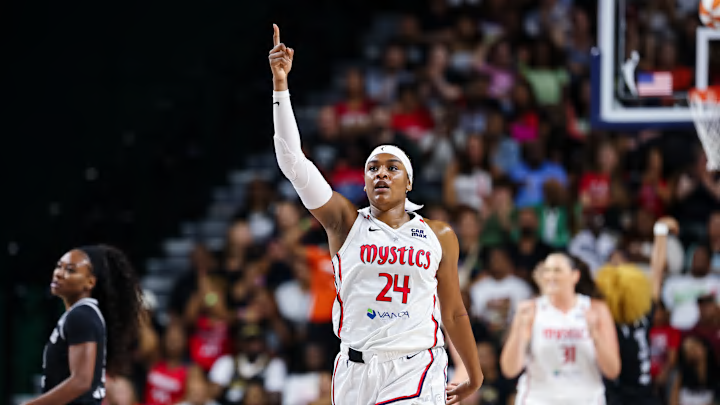With the WNBA's August 7th trade deadline looming, speculation has been swirling around the Washington Mystics and second-year forward Aaliyah Edwards. While the team navigates its rebuilding phase, reports across the league suggest multiple teams are interested in trading for her, posing a crucial question for the Mystics' front office.
As collegiate talent gets better and better and becomes more league-ready, the desire to gain future assets through trading Edwards is understandable, but the Mystics desperately need to resist this temptation. Moving her would be a short-sighted decision, undermining the very foundation of their rebuild and trading away a talent that still has massive potential.
Aaliyah Edwards has a lot of upside
The strongest argument against trading Edwards is in her youth and inherent upside. The 2024 No. 6 overall pick has the kind of raw talent that is difficult to acquire. Her skills were on display at the University of Connecticut, where she played in 139 games, averaged 27.7 minutes, 13.4 points, and 7.3 rebounds per game. She was also the first UConn player since Maya Moore to record a 20-point, 20-rebound game.
Even with reduced playing time, down to 14.2 minutes per game from 21.8 as a rookie, Edwards’s per-minute efficiency has actually increased, and she has played better this season. Projecting her stats to 40 minutes shows a significant jump in production, with her points rising from 13.9 to 18, her offensive rebounds increasing from 2.6 to about 3.7, and her steals seeing a slight uptick from 1.3 to around 1.4 compared to her rookie year, clearly showing she is continuing to develop.
From the financial side, her current rookie-scale contract is low cost, with high upside. To trade such a promising and affordable talent so early in her career would be a significant misstep, especially only one year out from her draft.
While her minutes have decreased in 2025 and she’s come off the bench more, this shouldn't be interpreted as stagnation. There are only five spots on the floor after all. Development in the WNBA is rarely linear, and adapting to different lineups and coaching is an important part of a player’s growth.
Despite the external noise surrounding trade rumors, Coach Sydney Johnson has publicly praised Edwards's professionalism and mental fortitude, stating his belief that she "definitely fits" within the team's vision. This faith should carry significant weight. It’s better to have too much talent than to be wondering how you only have eight active players when injuries or other commitments, like international tournaments, arise. Because of her low-cost contract, it’s also not a financial waste for her to come off the bench when necessary.
The Mystics have a deep frontcourt
However, these concerns about the Mystics having too much frontcourt talent, particularly with the emergence of rookie Kiki Iriafen, are understandable. Still, they are ultimately being overblown. The WNBA is a physically demanding league, and having multiple talented and versatile forwards is a necessity, not a luxury. Just ask the New York Liberty who are bringing in forward Emma Meesseman in addition to already having forwards Leonie Fiebich, Kennedy Burke, Isabelle Harrison, and Stephanie Talbot, as Breanna Stewart is currently dealing with an injury.
Think about the impact of an injury to either Iriafen or Shakira Austin. Edwards provides the ability to maintain a high level of play in the frontcourt. Also, this narrative overlooks the potential for Edwards and Iriafen to complement each other. Edwards played incredibly well in set-ups at UConn that featured forwards Olivia Nelson-Ododa, Dorka Juhász, and Aubrey Griffin. The Mystics need to view their presence as a strength, rather than a surplus. This is essential for building a deep and adaptable roster, and after the injury bugs that took out talented Mystics teams after their 2019 WNBA Championship, they should know that not having enough healthy talent will harm them.
It is important to acknowledge the existing rationale for trade talks. Iriafen's strong play has shifted Edwards' role, and the Mystics, 11th in offensive rating (9th in net rating), might want to rebalance their roster or acquire assets to address their perceived weaknesses as they push for the final playoff spot. Mock trades, such as a proposed deal involving Connecticut's Bria Hartley and draft picks, show the possibility of acquiring immediate veteran help and future flexibility.
However, Hartley's significant injury history, in particular, makes any potential return for her an imbalanced gamble with no guaranteed success. Additionally, with a WNBA team launching next season in Toronto, where Edwards went to high school, a future pathway for her to be a focal point on a team closer to home might prove more beneficial for her career growth than a trade to a non-contender like Connecticut.
Trading Aaliyah Edwards would be a mistake, undermining the Mystics’ commitment to developing young talent and potentially sacrificing a key piece of their future. While acquiring additional draft capital is tempting, the value of a proven young player already within the team’s system cannot be underestimated. The focus must remain on nurturing her talent and allowing her to grow alongside the team's other young prospects. Holding onto Aaliyah Edwards isn't just about retaining a talented player, it's about reaffirming their commitment to a long and sustainable path to success.
